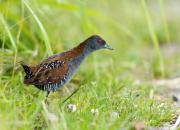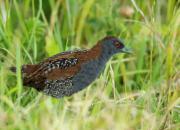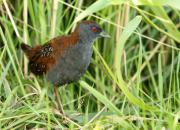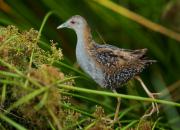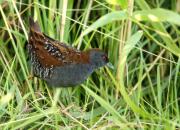info
It is quite unusual that among all my pictures of the birds in the family Rallidae that occur in Poland you cannot find the little crake but there is the baillon’s crake. Several times I tried to capture a little crake but I failed. Once a little crake practically marched under my lens, but it was impossible to take photo with my 400 mm lens from a distance of one meter. The bird completely overlooked that nearby, a few meters away, in the beautiful scenery of reeds there were crawling its favorite delicacies. Despite it is not a common bird in Poland its population is estimated at more than 1,000 individuals. Whereas the baillon’s crake proved presence in Poland dates back to several decades ago. So classifying this bird as a part of Polish fauna probably already should be seen in a historic aspect, or as an accidental occurrence. In recent years it was not seen by anybody here, perhaps also because of its size and very secretive lifestyle. It lives in wet meadows and its weight does not exceed 55 grams. We were really surprised by its small size. When we saw it for the first time (Jacek, Cezary, greetings) we looked at each other in amazement, because of its petite figure. It flitted among small clumps of grass, sometimes disappearing behind them. These pictures were taken in the Netherlands, where this bird is very rare. In the place where a baillon’s crake was said to appear numerous bird Dutch watchers came, such a sensation was its appearance in this country. Birds (in the pictures you can see a male and a female) emerged every few hours. We not always managed to take satisfactory images, as sometimes the bird literally slipped among the vegetation, it took just a second, two. Then an unbelievable reflexes and luck is needed to take a successful, clear picture. Only when it quietly preyed and sometimes stayed still did I manage to perform a satisfactory images, providing that the grass did not cover the bird. Once we could even see it flew 4-6 meters over the water, but during many attempts to photograph it, that lasted several hours, it was only one such a case, and there was no way to predict it and take the picture of the baillon’s crake on the fly. Its wingspan is about 35 centimeters. There are several subspecies of baillon’s crakes: in Europe, Asia, Australia, Africa, New Zealand and Madagascar. In Europe, however, it is a very rare bird and I am the more happy that I have managed to photograph it taking so many photos showing their environment. The bird was heard very rarely and it was difficult to record its sound. However, the audio recording was made, but I'm not sure if it was the sound of the baillon’s crake. As a rule first images are taken and then sound recording, so there is no possibility to confuse the soundtrack. This time it was different way. I made a sound recording but I did not see a bird while doing it. On this small area where the baillon’s crake occurred there were no other birds. On the right side and in front of us, a bit farther, we could hear water rails. In the distance, on the left we saw a spotted crake, a ruff and redshanks. The sound was recorded over several square meters and the probability that there was another bird is very small. So extremely rare and difficult to photograph species got to my photo gallery, and probably it will be difficult to make changes in this gallery for years. During this trip I also took pictures which initiate a photo gallery of the pied avocet, the bluethroat, the carrion crow, the common swift and the Muscovy duck.
Holandia-j.ANGIELSKI
Netherlands– introductory text - Baillon's crake
Nevs galleries:
1.Baillon's crake. 2.Pied avocet. 3. Bluethroat. 4. Carrion crow. 5. Common swift. 6. Muscovy duck.
Changes in galeries:
1. Barnacle goose.2. Barn swallow 3. Egyptian goose. 4. Lesser black-backed gull. 5. Sandwich tern. 6. Black-winged stilt.


